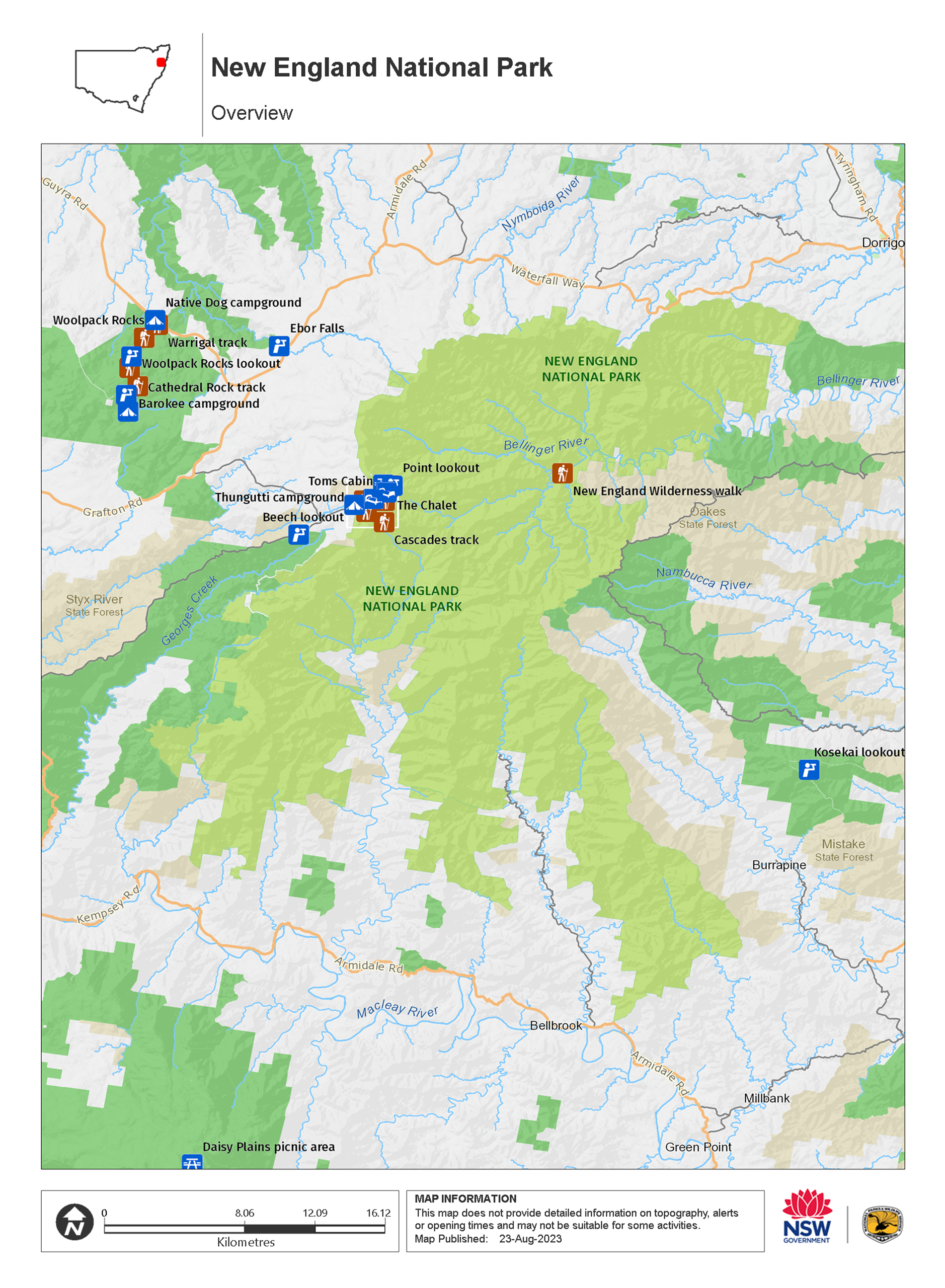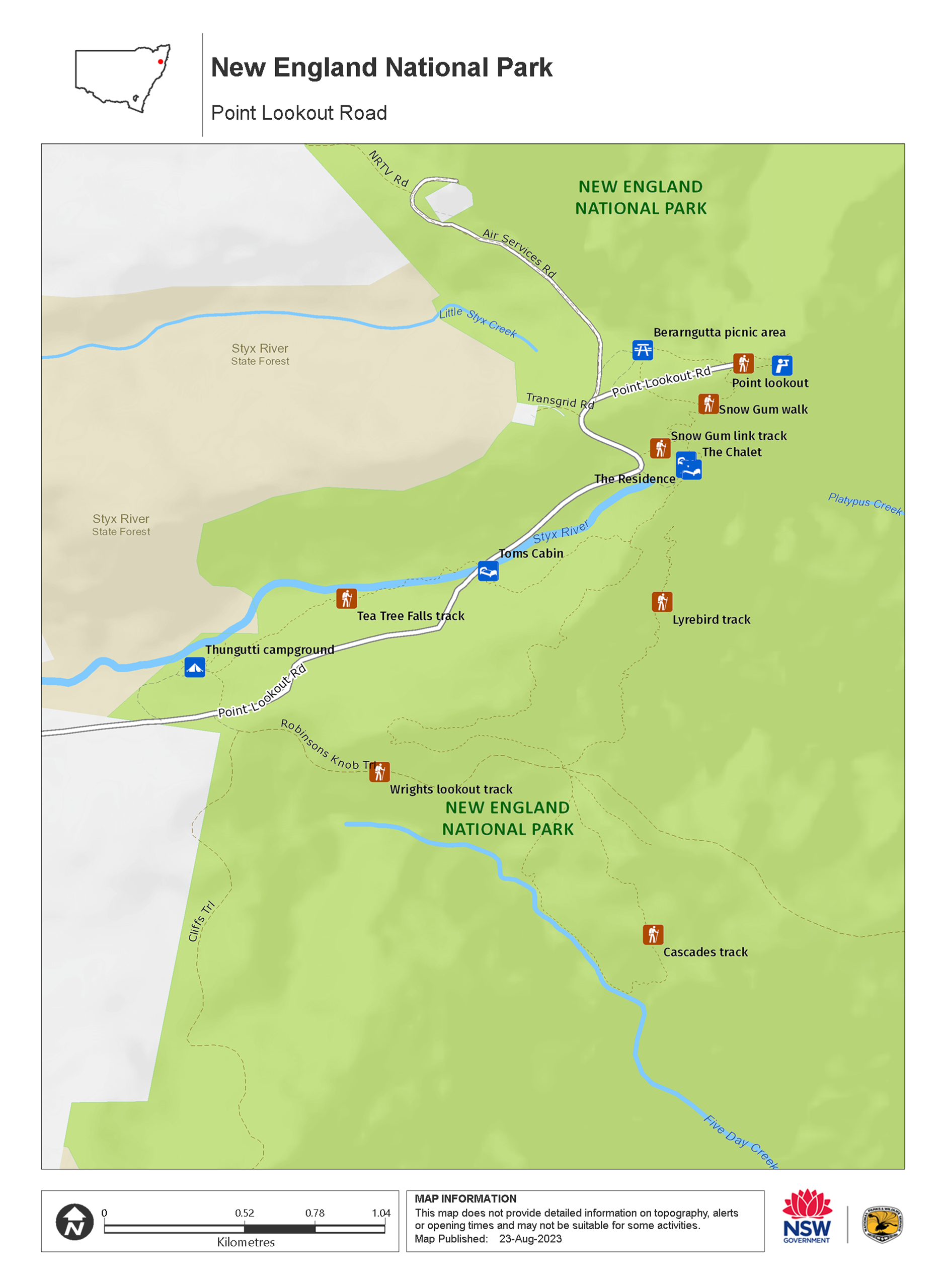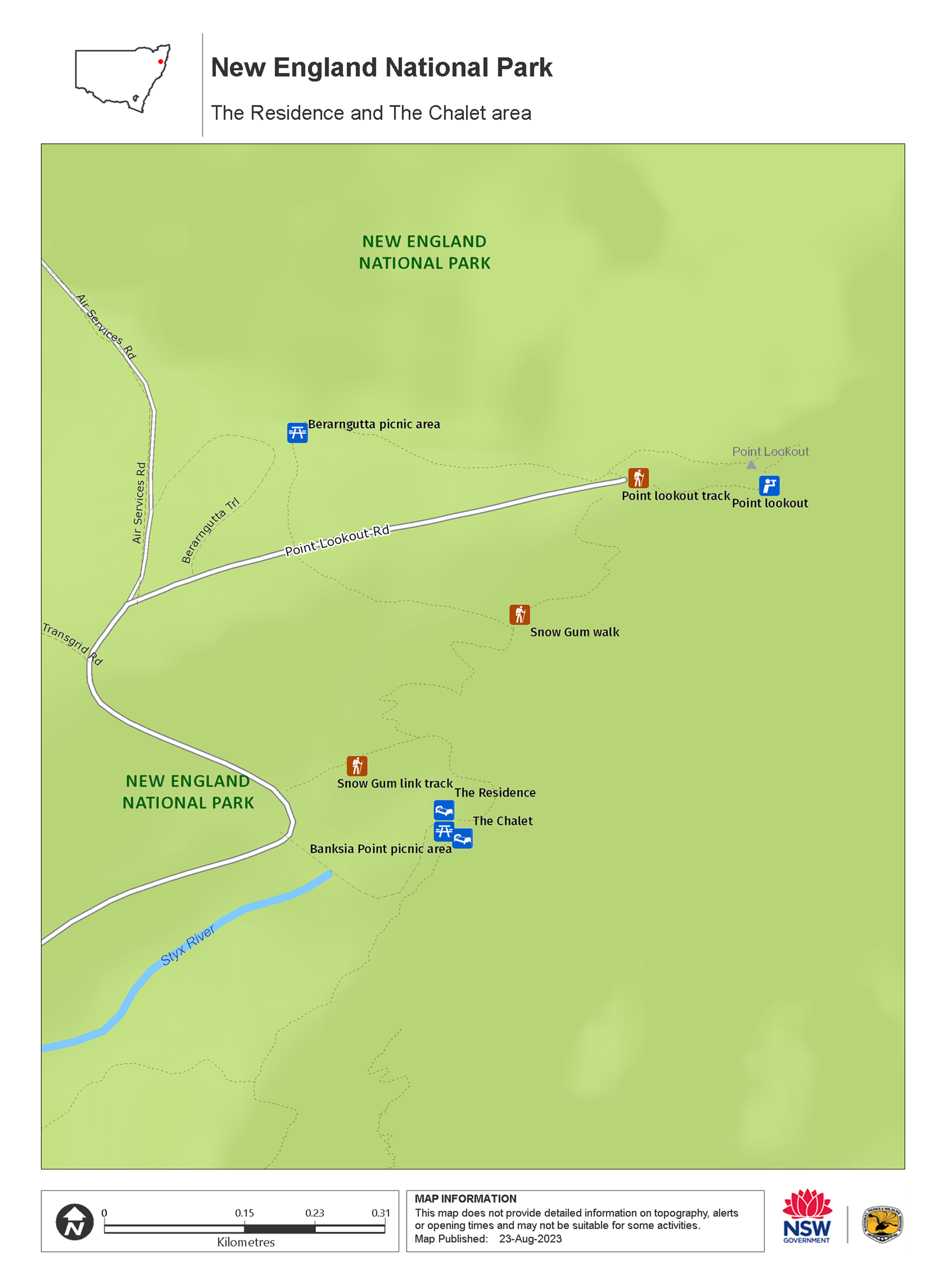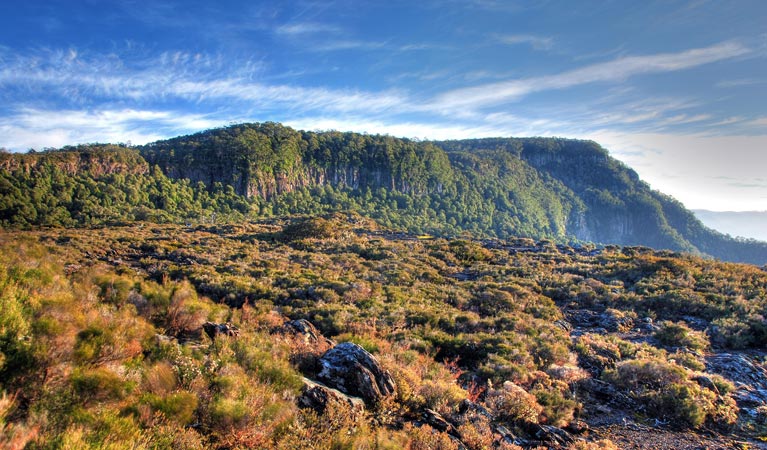New England National Park
Overview
Enjoy the natural beauty of New England National Park. It's home to World Heritage gondwana rainforest, and boasts magnificent views, fantastic walking and various accommodation options.
Read more about New England National Park
Located in the Northern Tablelands of NSW, New England National Park is a place of spectacular beauty and pristine wilderness. Part of the Gondwana Rainforests of Australia World Heritage Area, it offers visitors an unforgettable holiday experience or a peaceful weekend getaway.
Discover the ancient world sealed in Gondwana rainforest, wander through snow gum forests dotted with crimson rosellas, and see breathtaking views from the Great Escarpment on one of the many walking tracks. Walks range from an easy 200m stroll to multi-day hikes through remote wilderness.
Experience sensational sunrises and breathtaking views stretching over forested valleys all the way to the coast from Point lookout. Pack a picnic and spend a few hours admiring the spectacular view before you.
Visit for the day, or take advantage of the various accommodation and camping options and stay a few days while immersing yourself in this magical world.
Local alerts
For the latest updates on fires, closures and other alerts in this area, see https://www.nationalparks.nsw.gov.au/visit-a-park/parks/new-england-national-park/local-alerts
Map

Map

Map

Map legend

Contact
- in the North Coast and Country NSW regions
New England National Park is always open but may have to close at times due to poor weather or fire danger.
-
-
Coffs Harbour office
02 6652 0900
Contact hours: Monday to Friday, 8.30am to 4.30pm. - 4/32 Edgar St, Coffs Harbour NSW 2450
-
Email: npws.coffscoast@environment.nsw.gov.au
-
Coffs Harbour office
Visitor info
All the practical information you need to know about New England National Park.
- Getting there and parking
- Best times to visit
- Weather, temperature and rainfall
- Facilities
- Maps and downloads
- Safety messages
- Prohibited
- World Heritage rainforests
- Historic heritage
- Amazing wildlife
- Volcanic landscape
- Aboriginal cultural heritage
- Plants and animals protected in this park
- Preserving biodiversity
- Managing weeds pest animals and other threats
- Developing visitor facilities and experiences
- Conserving our Aboriginal culture
- Managing fire
Getting there and parking
Get driving directions
From Dorrigo:
- Travel west along Waterfall Way towards Armidale
- Turn left and continue through the township of Ebor
- After Ebor, turn left to stay on Waterfall Way heading towards Armidale.
- After about 7.6km, turn left onto Point Lookout Road which continues until the park entrance.
From Armidale:
- Travel east along Waterfall Way towards Ebor and Dorrigo
- About 7.6km before the township of Ebor, turn left onto Point Lookout Road which continues until the park entrance.
Parking
- Banksia Point picnic area See on map
- Berarngutta picnic area See on map
- Point lookout See on map
- Thungutti campground See on map
Road conditions and access
Point Lookout Road is a graded gravel road with a sealed section. The road is steep and narrow. It's suitable for 2WD and 4WD vehicles but road conditions and turnarounds aren't suitable for caravans.
- Unsealed roads
Vehicle access
- 2WD vehicles
Weather restrictions
- 4WD required in wet weather
By bike
Check out the Bicycle information for NSW website for more information.
By public transport
For information about public transport options, visit the NSW country transport info website
Best times to visit
There are lots of great things waiting for you in New England National Park. Here are some of the highlights.
Autumn
Enjoy the fresh air walking during the day, and cosy nights by the fire at Toms Cabin.
Spring
Climb up to Wrights lookout and see the colourful display of wildflowers.
Summer
Immerse yourself in the cool air and vibrant green of the Antarctic beech rainforest covered in moss.
Weather, temperature and rainfall
Summer temperature
Average
10°C and 24°C
Highest recorded
32.8°C
Winter temperature
Average
1°C and 12°C
Lowest recorded
-7.1°C
Rainfall
Wettest month
January
Driest month
June
The area’s highest recorded rainfall in one day
286.1mm
Facilities
Maps and downloads
Prohibited
Pets
Pets and domestic animals (other than certified assistance animals) are not permitted. Find out which regional parks allow dog walking and see the pets in parks policy for more information.
Smoking
NSW national parks are no smoking areas.
Nearby towns
Bellingen (39 km)
Bellingen is a laid-back, tree-lined town with a New Age vibe. It's set in a luxuriant valley beside the Bellinger River.
Dorrigo (39 km)
Dorrigo is a serene country town and the gateway to Dorrigo National Park. Its close to the edge of the escarpment above the Bellingen Valley.
Armidale (78 km)
During autumn the parks and gardens around Armidale show their beautiful colours. Enjoy a drive along the Waterfall Way, stopping at waterfalls and craggy gorges in the rugged countryside.
Learn more
New England National Park is a special place. Here are just some of the reasons why:
World Heritage rainforests

The rainforests in New England National Park are part of the Gondwana Rainforests of Australia World Heritage Area; the most extensive strip of diverse rainforest anywhere on earth. The World Heritage Area is a direct window into the past and the future, providing a link to the ancient pre-human world and a stunning and irreplaceable record of life on our planet. Discover the ancient Antarctic beech forests below the escarpment edge on trails like Lyrebird walking track.
- Snow Gum walk Snow Gum walk in New England National Park offers a scenic stroll through World Heritage rainforest. Just 1km and suitable for all ages, it’s ideal as a quick family outing.
Historic heritage

In 2010, New England National Park celebrated its 75th anniversary as one of NSW's most iconic parks. Its history is a testament to the vision and dedication of several influential New Englanders, notably Philip A Wright and his son Peter. They were deeply impressed by the beauty and grandeur of Point Lookout and recognised the value of the area as a sanctuary for plants and animals. After you see the spectacular views at Point Lookout, take a moment to learn about the history of the park and the visionary people behind its conservation.
Amazing wildlife

The park's altitudinal range, from 150m above sea level to 1563m, makes it a superb habitat for a diversity of wildlife. You might see kangaroos, wallabies, gliders, possums and the inquisitive spotted-tailed quoll. Adults and children alike will love watching the resident lyrebird at Banksia Point. Yet with over 100 species of birds in the park, there are plenty of opportunities for birdwatching. You might spot white-throated tree creepers and rufous fantails in the open forests, while in winter flowering banksias attract Lewins honeyeaters and eastern spinebills.
- Point lookout walking track It only takes 20 minutes to negotiate the easy Point lookout walking track, but the views from this sealed track, within New England National Park, are truly stunning.
- Wrights lookout walking track Wrights lookout walking track takes you through a lush world of ferns and wildflowers to a rocky plateau with spectacular panoramic views looking down to Bellinger River.
Volcanic landscape

The steep cliffs of the plateau edge at New England National Park are the result of at least 5 basalt lava flows from the Ebor volcano, forming a rim over 300m thick. Active until about 18 million years ago, this massive volcano was centred around The Crescent, a semi-circular ridge in the Bellinger Valley, visible from Point Lookout. Subsequent erosion has created the dramatic profile of the escarpment we see today. The Banksia Point circuit provides a close-up view of a basalt flow, and you can see the layers of cliffs north from Point lookout.
- Point lookout Point lookout is a must-see destination for visitors to New England National Park, offering panoramic views across World Heritage rainforest to the ocean in the distance.
- Tea Tree Falls walking track Roam through eucalypt forest and beneath hanging moss on Tea Tree Falls walking track, linking Thungutti campground and Toms Cabin in New England National Park.
Aboriginal cultural heritage

The park straddles the traditional boundaries of the Dunghutti, Anaiwan and Gumbaynggirr People, and covers an area of great spiritual and cultural significance to local Aboriginals. Point Lookout in particular is a sacred location, known to Aboriginal people as 'Berarngutta', which roughly translates as 'prohibited area'. It is considered a men-only place, and today many Aboriginal women choose to continue this tradition and avoid visiting the area.
- Point lookout Point lookout is a must-see destination for visitors to New England National Park, offering panoramic views across World Heritage rainforest to the ocean in the distance.
Plants and animals protected in this park
Animals
-

Superb lyrebird (Menura novaehollandiae)
With a complex mimicking call and an elaborate courtship dance to match, the superb lyrebird is one of the most spectacular Australian animals. A bird watching must-see, the superb lyrebird can be found in rainforests and wet woodlands across eastern NSW and Victoria.
-

Satin bowerbird (Ptilonorhynchus violaceus)
With vibrant blue-violet eyes and curious antics, the satin bowerbird is a favourite for bird watching and easy to spot as it forages for food in open forest. Relatively common across eastern Australia, in NSW they’re found in coastal rainforests and adjacent woodlands and mountain ranges.
-

Rufous scrub-bird (Atrichornis rufescens)
The vulnerable rufous scrub-bird is a small, ground-foraging bird that lives only in isolated rainforest areas of south-eastern Australia.
-

Spotted-tailed quoll (Dasyurus maculatus)
The spotted-tailed quoll is the largest remaining carnivorous marsupial on the Australian mainland. It’s protected as a vulnerable species in NSW.
Plants
-

Blueberry ash (Elaeocarpus reticulatus)
The blueberry ash is a rainforest shrub which produces blue olive-shaped berries and spectacular bell-shaped flowers, which often appear on the plant together. It is a tall slender shrub or small tree found in rainforest, tall eucalypt forest and coastal bushland in eastern NSW, south-east Queensland and Victoria.
-

Wonga wonga vine (Pandorea pandorana)
The wonga wonga vine is a widespread vigorous climber usually found along eastern Australia. A variation of the plant occurs in the central desert, where it resembles a sprawling shrub. One of the more common Australian native plants, the wonga wonga vine produces bell-shaped white or yellow flowers in the spring, followed by a large oblong-shaped seed pod.
-

Coachwood (Ceratopetalum apetalum)
Coachwood trees are Australian native plants that grow in warm temperate rainforests along coastal NSW. Also known as scented satinwood, the mottled grey bark of the coachwood has horizontal markings and a delicate fragrance.
Environments in this park
School excursions (1)
What we're doing
New England National Park has management strategies in place to protect and conserve the values of this park. View the detailed park and fire management documents. Here is just some of the work we’re doing to conserve these values:
Preserving biodiversity
New England National Park embraces efforts to support the biodiversity of its flora and fauna and to enhance the visitor experience at the same time. Restoration, conservation and bush regeneration activities are regularly carried out within this park and programs to maintain biodiversity are widespread and ongoing.
Managing weeds, pest animals and other threats
Pests and weeds have a significant impact to the ecosystems within New England National Park. NPWS carries out risk assessments for new and emerging weeds such as cats claw creeper and cherry guava to protect biodiversity in this park.
Developing visitor facilities and experiences
NPWS is committed to providing ample facilities for visitors to enjoy. New England National Park frequently evaluates its visitor offerings to ensure park visitors are well catered for. Tourist accommodation, including the park’s campgrounds, is regularly reviewed, serviced and maintained to a high standard.
Conserving our Aboriginal culture
NPWS honours the Aboriginal heritage of New England National Park, and strives to ensure this heritage is appropriately recognised, supported and conserved. NPWS works closely with local Aboriginal communities and cultural programs and initiatives are in place within this park.
Managing fire
NSW is one of the most bushfire prone areas in the world as a result of our climate, weather systems, vegetation and the rugged terrain. NPWS is committed to maintaining natural and cultural heritage values and minimising the likelihood and impact of bushfires via a strategic program of fire research, fire planning, hazard reduction, highly trained rapid response firefighting crews and community alerts.

